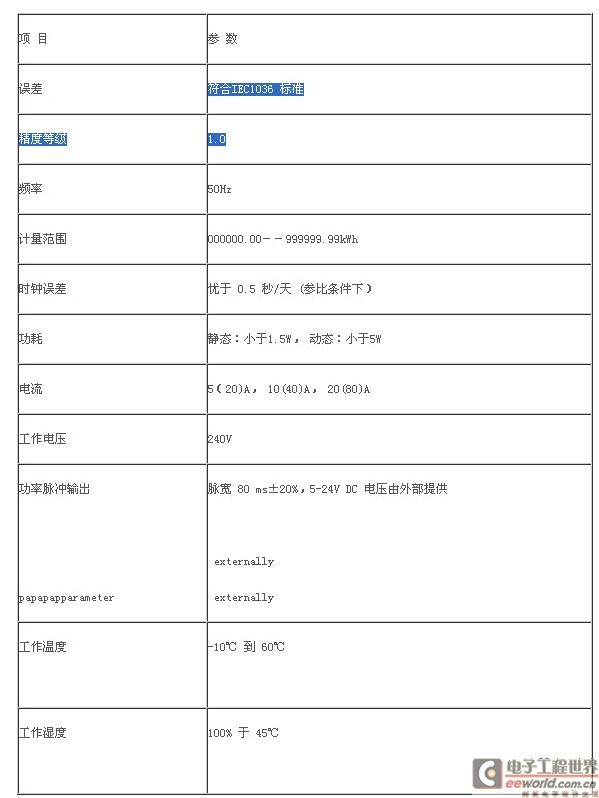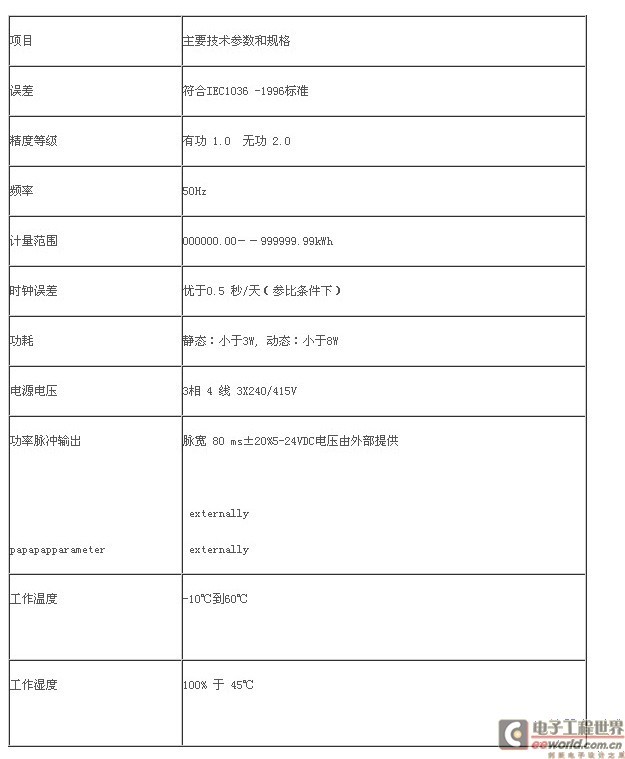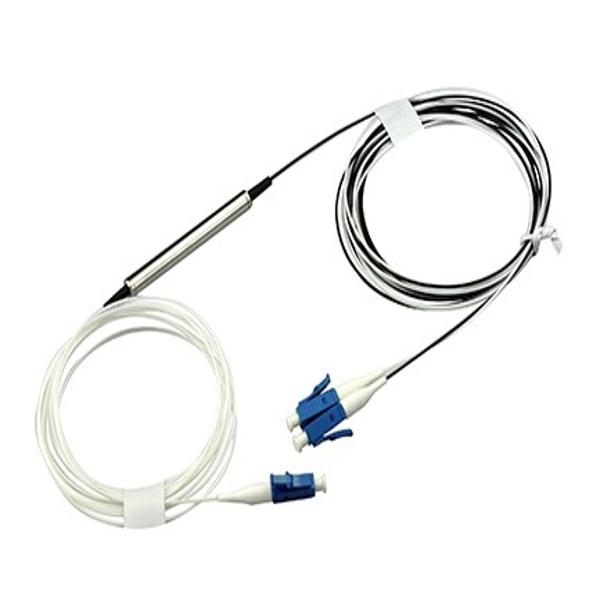The first part of the current local energy measurement status 1.1 current energy measurement status a) Each power company is still mainly using mechanical energy meters and low-cost electronic meters for energy measurement, the accuracy level is mostly 2 b) due to electricity theft The distribution of phenomena and grid lines has a high line loss rate, and some individual areas are estimated to be above 20%. Because mechanical energy meters do not accurately calculate line losses, almost all data is "estimated".
c) Because there is no monitoring between the master and the minute, it is difficult to find and locate the line loss location.
d) The traditional post-paid system implemented throughout the country makes recycling tax more difficult.
e) Manual meter reading leads to frequent errors and waste of time and resources. And because it is not at the same time, it is difficult to perform accurate post-electric energy data analysis and line loss analysis.
Urgent problem currently 1.2 a) improve the accuracy of the meter rating b) reducing line losses and losses position location line c) recovering electricity timely and accurate d) reducing the cost of meter reading <br> a second portion of power line carrier automatic meter reading system Introduction 2.1 System function description a) In order to ensure timely recovery of electricity charges, the power company can remotely power off the arrears users at the main station. b) Use high-precision all-electronic energy meters c) Use power line carrier remote communication technology for users The electrical condition is monitored to prevent the user from stealing electricity.
d) Accurately locate the line loss location by analyzing the data from the summary and sub-tables
2.2 System Schematic <br> As shown below:

As can be seen from the above figure, the low-voltage power line carrier automatic meter reading system includes three partial units:
a) Computer Master System: Used to collect, store, and analyze data. Typically this unit is located in the office of the power company's management department – ​​for example, the meter reading center in the power sector in District xx, New Delhi, India. The main hardware consists of a data server (for storing data), a management front-end (for managing data), and a meter reading front-end (for reading back data and storing it in the data server). The system is connected by a local area network and connected to the internet for data interaction with each point of sale.
b) Data concentrator unit: Installed on the low voltage side of the transformer 240/415V. Communication between the data concentrator unit and the primary station can be achieved via PSTN, GSM, GPRS, RS232 or CDMA, while communication between the concentrator and the meter is achieved via low voltage power line carrier technology.
c) Terminal unit: an electronic multi-function meter independently developed for our company. They transmit data to the concentrator via low voltage power line carrier communication.
The electricity sales system is independent of the automatic meter reading system and can be located at a bank or any other point of sale (PoS). Through the Internet, the data of the point of sale can be transmitted to the primary station. In addition, the system is also a real-time online system, and the sales information of the point of sale is also transmitted to the main station in real time via the Internet. Users can choose their own point of sale to purchase electricity.
Part III Implementation Details 3.1 Payment Details (taking the existing system as an example):
All meters will freeze the data at 00:00 on the first day of each month, and the concentrator will automatically read and store the data for the next 5 days. On the fifth day of each month, the main station reads back the frozen data from the concentrator, generates an electricity bill, and then automatically prints it by the meter reading machine.
The electricity bill must be delivered to the user before the 10th of each month. The user can pay the bank at the end of each month on the receipt of the receipt. If the user does not make the payment in time (the payment information can be verified in the main station software), the power company can give the user a written notice to remind him to make the payment within 5 days of the grace limit. If the user still has not paid within 5 days, the power company can remotely power off the user at the primary station until it replenishes the amount due and then resumes power-on.
3.2 Stealing methods and penalties <br> Stealing electricity requires changing the communication connection of the power line at the end of the watch. In some cases, even if the meter has a phase sequence error or reverse, the meter can still be accurately measured. However, due to changes in the connection of the meter, low-voltage power line carrier communication will stop, and it is easy to detect and locate such behavior at the primary station. The power company can check whether the communication interruption is caused by tampering or meter failure by troubleshooting the subscriber's line. In other cases, even if the stealing user changes the way the meter is connected to steal electricity, the meter can still communicate normally. In this case, the approximate location of the tampering is determined by comparing the total table data with the sum of the sub-list data, and then the power company can easily locate the line loss or sneak electricity by manually checking the line. Â
The specific punishment measures shall be decided by each power company.
Part IV Specifications of Electric Meters <br> 1. Single-phase electric energy meter FD129
FD129 is a multi-function metering SOC product PL3201 based on our own research and development and owning intellectual property rights.
1. Basic technical parameters

2. The main function
Measurement parameters:
# Active energy: reverse and reverse measurement is still accurate error indication.
#æ— åŠŸèƒ½é‡
#电数æ®å†»: It can be used to print monthly electricity bills on the monthly preset energy data freeze date.
#实时钟 and calendar: Automatic leap year adjustment, external battery can maintain 10 years life in case of power failure.
# Active energy pulse output: for calibration, collection power, passive isolated output port
#通信 function: support infrared and low voltage power line carrier communication
#Display function:
·LCD displays 6-digit integer, 2 decimal places
·Automatic display
·Set the items to be displayed through the infrared handheld meter reading device
· Each display shows 4 seconds
The display items are:
·date
·time
·Electric meter address
·Electric meter constant
·Active energy
·Reactive energy
·Power on LCD display test
#Data saving: After power off, all data can be kept for more than 10 years.
#ä¿æŠ¤çº§:IP51
3. Communication function
The FD129 supports the use of infrared and low voltage power line carrier communications for data transmission. Low-voltage power line carrier communication is used for remote automatic meter reading and monitoring of meter operation status. The main station can analyze the electricity theft and line loss last month. Infrared communication is used for local meter reading and setting meter parameters.
The following is a brief description of the functions of the various communication types:
a) Low voltage power line carrier communication
- Meter reading: copying frozen data or performing real-time copying
- Freeze data: 12 months of active energy
- Point copy (refers to the current data item of each meter in real time): current active, 12 months of active freeze data, meter constant, date, automatic freeze date and balance.
b) Infrared communication
- Meter reading: Use PDA to copy back active power, reactive power, 12 months of active freeze data, meter constant, date and time, and automatic freeze date.
- Meter settings: table number, password, and freeze date.
Second, three-phase multi-function electric meter FD130
FD130 is a based on PL3223 (phase multifunction measurement chip) PL3201 phase and multi-function meter, along with low-voltage power line carrier communications.
1. Basic technical parameters

2. The main function
Measurement parameters:
# Active energy: reverse and reverse measurement is still accurate error indication.
#æ— åŠŸèƒ½é‡
#电数æ®å†»: It can be used to print monthly electricity bills on the monthly preset energy data freeze date.
#实时钟 and calendar: Automatic leap year adjustment, external battery can maintain 10 years life in case of power failure.
# Active energy pulse output: for calibration, collection power, passive isolated output port
#通信 function: support infrared and low voltage power line carrier communication
#Display function:
·LCD displays 6-digit integer, 2 decimal places
·Automatic display
·Set the items to be displayed through the infrared handheld meter reading device
· Each display shows 4 seconds
The display items are:
·date
·time
·Electric meter address
·Electric meter constant
·Active energy
·Reactive energy
·Power on LCD display test
#Data saving: After power off, all data can be kept for more than 10 years.
#ä¿æŠ¤çº§:IP51
4. Communication function
The FD130 supports infrared and low voltage power line carrier communication for data transmission. Low-voltage power line carrier communication is used for remote automatic meter reading and monitoring of meter operation status. The main station can analyze the electricity theft and line loss last month. Infrared communication is used for local meter reading and setting meter parameters.
The following is a brief description of the functions of the various communication types:
a) Low voltage power line carrier communication
- Meter reading: copying frozen data or performing real-time copying
- Freeze data: 12 months of active energy
- Point copy (refers to the current data item of each meter in real time): current active, 12 months of active freeze data, meter constant, date, automatic freeze date and balance.
b) Infrared communication
- Meter reading: Use PDA to copy back active power, reactive power, 12 months of active freeze data, meter constant, date and time, and automatic freeze date.
Meter settings: table number, password, and freeze date.
DWDM - Dense WaveLength Division Multiplex
DWDM (Dense Wavelength Division Multiplexing) is the ability to combine a group of optical wavelengths with a single optical fiber for transmission. This is a laser technology used to increase bandwidth on existing fiber optic backbone networks. More precisely, this technology multiplexes the tight spectral spacing of a single fiber carrier in a specified optical fiber in order to take advantage of the achievable transmission performance (for example, to minimize dispersion or attenuation). In this way, under a given information transmission capacity, the total number of optical fibers required can be reduced.


Dense Wdm,Dense Splitter,Dense Wdm Splitter
Shenzhen GL-COM Technology CO.,LTD. , https://www.szglcom.com